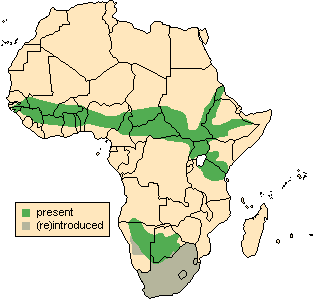![]() Return
to Artiodactyla
Return
to Artiodactyla
Classification
|
 Alcelaphus
buselaphus
Alcelaphus
buselaphus
Hartebeest
![]()
Taxonomy
 |
 |
 |
Click on the pictures above for a larger view of the
photographs
|
||
General Characteristics
Body Length: 175-245 cm / 5.8-8.1 ft.
Shoulder Height: 120-145 cm / 4-4.8 ft.
Tail Length: 45-70 cm / 1.5-2.3 ft.
Weight: 120-200 kg / 264-440 lb.The colouration of the hartebeest varies dramatically between subspecies, from light tan through bright rufous to deep maroon. In addition, there may be blackish markings on the head and legs, while the haunches and rump are generally lighter. The body slopes from the high shoulders down to the hindquarters, terminating with a black-tasseled tail. The legs are proportionately long and built for speed. The head is extremely elongated and narrow, a shape emphasized by the high placement of the eyes and the high horn pedicel. The strongly ridged horns are found in both sexes, growing 45-70 cm / 1.5-2.3 feet long. Showing considerable variation, they generally curve out sideways, then forwards, and finally inwards and backwards, with the sharp tips facing the rear.
Ontogeny and Reproduction
Gestation Period: 8 months.
Young per Birth: 1
Weaning: After 4 months.
Sexual Maturity: At 1.5-2.5 years.
Life span: Up to 19 years.Breeding takes place throughout the year, although local populations may have seasonal peaks.
Ecology and Behavior
The hartebeest, like many antelope, is primarily diurnal, grazing in the early morning and late afternoon, and resting in a shaded area during the hottest part of the day. During feeding periods, a sentry watches for potential sources of danger, and can often be seen standing on a termite mound in order to increase the range of visibility. When fleeing, the herd runs in single file, and can reach speeds of up to 80 kmph / 48 mph. At 3-4 years of age, males attempt to hold a territory. Marked with dung piles, these defended regions average 31 hectares in area, and are generally taken over by another male after 4-5 years. Females and males alike are generally non-aggressive, although both sexes will fight vigorously in defense of their offspring or territory. Population densities average 1.4 animals per square kilometer.Family group: Single sex and mixed groups of 5-20 individuals, with a maximum of about 300.
Diet: Grasses, rarely leaves.
Main Predators: Lion, leopard, cheetah, spotted hyena, Cape hunting dog.
Distribution
Open grassland and bush regions throughout sub-Saharan Africa.

Range Map (Redrawn from IEA, 1998)
Conservation Status
The hartebeest is classified as a low risk, conservation dependent species by the IUCN (1996). The subspecies A. b. caama, A. b. cokei, A. b. lelwel, and A. b. major are also classified as low risk, conservation dependent, while A. b. swaynei and A. b. tora are endangered. Sadly, A. b. buselaphus is believed to be extinct.
Remarks
Hartebeest is thought to be Africaans for "tough beast", a reference to this antelope's tirelessness when being chased. Alke (Greek) the elk; elaphos (Greek) a deer. Bous (Greek) a cow.
Literature Cited
IEA (Institute of Applied Ecology). 1998. Alcelaphus buselaphus. In African Mammals Databank - A Databank for the Conservation and Management of the African Mammals Vol 1 and 2. Bruxelles: European Commission Directorate. Available online at http://gorilla.bio.uniroma1.it/amd/amd149b.htmlKingdon, J. 1997. The Kingdon Field Guide to African Mammals. Academic Press, London and New York: NaturalWorld.
Nowak, R. M. [editor]. 1991. Walker's Mammals of the World (Fifth Edition). Baltimore: The Johns Hopkins University Press.
Walther, F. R. 1990. Hartebeests. In Grzimek's Encyclopedia of Mammals. Edited by S. P. Parker. New York: McGraw-Hill. Volume 5, pp. 418-436.
Wilson, D. E., and D. M. Reeder [editors]. 1993. Mammal Species of the World (Second Edition). Washington: Smithsonian Institution Press. Available online at http://nmnhwww.si.edu/msw/
Return to Artiodactyla

![]()
© Brent Huffman, www.ultimateungulate.com |
|
|